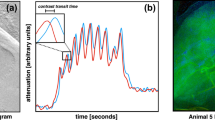Abstract
The use of CO2 as a contrast agent has increased significantly for visualization of the central veins, inferior vena cava, and portal vein. The most serious complication associated with CO2 studies is air contamination. We evaluated a simple digital subtraction angiogram (DSA) method to detect air contamination during CO2 venous studies. After injections of 5, 10, and 20 cm3 of CO2 and 5 cm3 of air into the inferior vena cavas of five domestic swine in the left lateral decubitus position, a DSA was performed using the cross-table lateral projection to visualize the gases trapped in the right atrium. The time to complete dissolution of CO2 at increased doses was compared to that of air. Vital signs were observed during and after CO2 or air injection. In all animals, DSA showed the trapped gas outlining the wall of the right atrium. Five cubic centimeters of CO2 was cleared from the right atrium in an average of 46 sec (21–60 sec), whereas 5 cm3 of air remained visible over 5 min. Ascending doses of CO2 increased the time of dissolution to 54 sec (47–67 sec) for 10 cm3 and 70 sec (45–90 sec) for 45 cm3. Vital signs remained stable during the study. Using DSA, CO2 can be distinguished from air by demonstrating rapid absorption of the former, thus allowing detection of air contamination during CO2 venous studies. If the gases trapped in the right atrium remain visible 90 sec after the injection, air contamination should be suspected.



Similar content being viewed by others
References
Hans ST, Pfammatter T, Cho KJ (1995) Carbon dioxide gas as a venous contrast agent to guide upper-arm insertion of central venous catheters. Cardiovasc Intervent Radiol. 18:146–149
Sullivan KL, Bonn J, Shapiro MJ, et al. (1995). Venography with carbon dioxide as a contrast agent. Cardiovasc Intervent Radiol 18:141–145
Hawkins I, Johnson A, Caridi J, et al. (1997) CO2 fine needle TIPS. J Vasc Intervent Radiol 8:235–239
Shepard DG, Moss J, Miller M (1998) Imaging of the portal vein during transjugular intrahepatic portosystemic shunt procedures: a comparison of carbon dioxide and iodinated contrast. Clin Radiol 53:448–450
R Boyd-Kranis KL Sullivan DJ Eschelman, et al. (1999) Accuracy and safety of carbon dioxide inferior vena cavography. J Vasc Intervent Radiol 10 (9):1183–1189
Sing RF, Stackhouse DJ, Jacobs DG, et al. (2001) Safety and accuracy of bedside carbon dioxide cavography for insertion of inferior vena cava filters in the intensive care unit. J Am Coll Surg 192 (2):168–171
Hawkins IF Jr., Caridi JG, Klioze SD, et al. (2001) Modified plastic bag system with O-ring fitting connection for carbon dioxide angiography. Am J Radiol 176:229–232
Author information
Authors and Affiliations
Corresponding author
Rights and permissions
About this article
Cite this article
Cho, K.J., Cho, D.R. & Hawkins, I.F. A Simple DSA Method to Detect Air Contamination During CO2 Venous Studies. Cardiovasc Intervent Radiol 29, 642–645 (2006). https://doi.org/10.1007/s00270-005-0009-0
Published:
Issue Date:
DOI: https://doi.org/10.1007/s00270-005-0009-0




